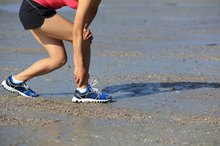What Causes Pain When Performing Leg Raises?
Lower back pain can be caused by tweaked muscles or strain to the SI joint and lower back fascia. The muscles of the lower back can often be injured if the core isn't strong enough, or the hands aren't placed behind the tail bone during leg raises. Pain from lifting your legs while lying on your back can also be the result of sciatica. Actually, many medical professionals use leg raises as part of a basic muscle test to help diagnose this condition.
Symptoms
Pain associated with sciatica can range in intensity from mild to severe. It usually begins in the lower back and radiates down into the buttocks. Sometimes, this pain can continue down into the leg and is accompanied by the sensations of numbness, tingling, burning or prickling, according to the American Academy of Orthopaedic Surgeons. Weakness of the muscles can occur as well.
- Pain associated with sciatica can range in intensity from mild to severe.
- Sometimes, this pain can continue down into the leg and is accompanied by the sensations of numbness, tingling, burning or prickling, according to the American Academy of Orthopaedic Surgeons.
Development
5 Things You Need to Know About Symptoms Of Sciatic Nerve Pain
Learn More
Most often, sciatica develops as a result of compression of the sciatic nerve root within the lower back. The American Medical Association claims that herniated or slipped disks are the most common cause of this pain, but you may also suffer pressure on the nerve root due to tumors, trauma and spinal stenosis. The latter is a narrowing somewhere within the spinal column. Even muscle spasms in the lower back can compress the sciatic nerve and lead to sciatica.
- Most often, sciatica develops as a result of compression of the sciatic nerve root within the lower back.
- Even muscle spasms in the lower back can compress the sciatic nerve and lead to sciatica.
Effects
Though many people can recover from the pain on their own, leaving sciatica untreated can result in nerve damage. This may result in a loss of feeling in the affected leg as well as a loss of movement. Occasionally, people experience impaired bowel or bladder function.
Treatment
Sciatica and the Big Toe
Learn More
Bed rest, coupled with non-steroidal anti-inflammatory drugs, helps lessen inflammation that places pressure on the sciatic nerve and subsequently relieve pain. If pain is moderate to severe, muscle relaxants may be necessary. However, roughly 80 percent to 90 percent of people experience improvement with this method of self-care treatment, notes the American Academy of Orthopaedic Surgeons.
Medical Intervention
If self-care measures fail to improve the pain, you may need to take part in physical therapy to correct your posture as well as improve the strength and flexibility of the lower back muscles. From there, steroidal injections and surgical procedures can help correct the compression placed on the sciatic nerve root.
Related Articles
References
Writer Bio
Based in Minneapolis, Minn., Dana Severson has been writing marketing materials for small-to-mid-sized businesses since 2005. Prior to this, Severson worked as a manager of business development for a marketing company, developing targeted marketing campaigns for Big G, Betty Crocker and Pillsbury, among others.









